By R.K. Campbell
Contributing Editor
Not long ago a deal was struck with my friend Tommy and money exchanged hands for a rather nice Smith & Wesson Model 12. Tommy said, “Hold on a second, I have a holster that I might as well throw in with the deal.” I thought he was rummaging through his foot locker but when the holster was presented it looked like it was dug out of the dump.
The holster staked a claim on leather construction but it looked more like cardboard. The Model 12 .38 Special slipped into the holster like my wife’s dainty foot into a size 12 brogan. The holster’s grip on the long bearing surfaces was non-existent. There was enough lateral play to convince the user he had placed a rat in a skunk hole.
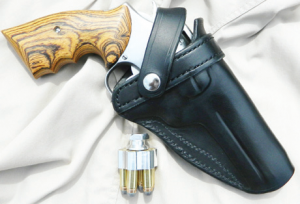
This holster from Holster Pro carries the author's favorite carrying .357 Magnum. (Note Ahrends grips.) The light weight speedloader is from Five Star Firearms.
This may seem an extreme example but the fact is it is the penny pinchers that often get taken. I have seen an older gentleman of my acquaintance carry his pistol in a cheap fabric holster with the butt tilted almost to falling out of his pants. Within the week I was surprised to see an employee at a shop with a light pistol stuck into a cheap inside-the-waistband (IWB) holster that featured a plastic clip. Not only was the combination cheap as dirt, the gun and holster were tucked into the seam of his sweat pants and worn without a belt! Such a combination is not only worthless it is patently unsafe. I was a peace officer for most of my life and I have hunted with a handgun on my side since I was out of three-cornered britches. I know what is needed when it comes to leather and the recipe and requirements are not that difficult.
Just the same, some folks don’t get it and when they don’t, they end up carrying a far less effective handgun than they could have carried, and they also end up with an unsafe and totally unsatisfactory combination. Let’s look at some of the requirements for a good holster and perhaps you will gain a little knowledge.
First the material! All cow leather isn’t the same. The best piece on the bull is the saddle skirting leather that comes off of the bull’s shoulder. This is a stiff and long lasting cut that will hold the welt when sewn together. The tab that is cut and stitched to the body for the belt loop also needs to be of first class leather. Think about the knocks and scuffs that a saddle gets going through thistles and briars and you will understand why skirting leather is so important. This high grade of leather along with shell horsehide is the premium material for making a holster.
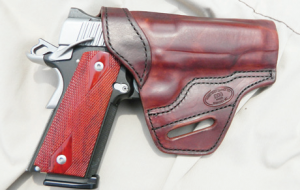
A relatively new maker is Rocky River Leather Company. Note the molding, not too tight, allowing good speed, but tight enough for excellent retention.
Next is the fit, molding or boning.
The holster material must be wet pressed to fit the roscoe properly. A good tight fit allows security and after the break-in period makes for real speed on the draw. The holster should be properly molded, boned or fitted to the individual handgun. Those who use a fit-them-all holster or a soft holster that fits more than one handgun just really don’t get it. The presentation from leather must be properly executed as the presentation leads the gun into the target. The presentation is part of the move into the firing stance and the presentation from leather is also part of the sight acquisition process. It should be smooth and seamless. Speed comes with time, but speed will never come with a poorly fitted holster. The holster must fit the handgun.
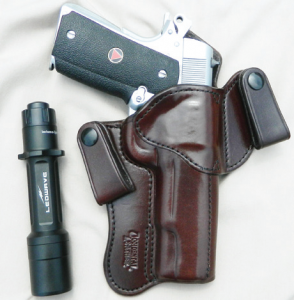
This IWB from Occidental Leather is first class from the holster welt to the toe. This holster concealed the powerful Colt Delta Elite 10mm comfortably. The Strategos Secutor light is a must-have all-around combat light.
My first good handgun scabbard came from Don Hume Leathergoods. At the time most self-loading designs were simply revolver holsters with the cylinder bulge ironed out. The Don Hume duty holster was solid and gave excellent service with my Colt Government Model .45. Later I discovered the gun-hugging concealment model. With the handgun tilted forward and the handgun carried high on the waist I could conceal a larger handgun. Don Hume’s holsters, including the remarkable Model 721, gave good speed and retention with an absolute minimum of good but flexible gun leather.
Since Tom Threeperson’s first developed the Threepersons holster, we have found that less is more. Threepersons cut a goodly amount of unnecessary leather off of the Mexican loop holster to perfect his holster.
Later, the original Roy Baker pancake holster gave us less is more in a design that was to be highly influential on the concealment scene.
I still own one of the originals and while it is quite worn it is serviceable 20 years after the fact. Meanwhile someone decided that a heavier holster was needed when hunting. If a holster will hold the piece close to the body for concealed carry, it is just fine for hunting use. Yet some continue to use the flap holster. I like a good flap holster such as the ones from Triple K for storage, and the holsters are wonderful for both looks and service.
But for hunting I usually use a Western style holster such as the ones offered by John Bianchi’s Frontier Gunleather.
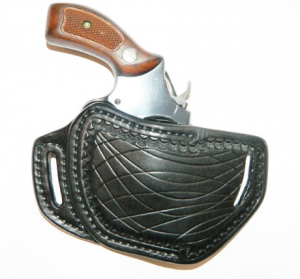
This holster from Jeff Silverster of Silver Star is designed to keep the holster tight to the body and it does. This is a first class design that is also well executed.
Speed isn’t the issue. The flap holster is for protection against the elements.
When the person pushing the flap holster mentions the elements they seem to be in fear of something arcane.
But the only elements I know we are choosing a good gun holster likely to run across when hunting are water and ice. If you are out for a little while in the weather, simply wipe the hogleg off and oil it upon your return.
If the flap holster becomes soaked with water as it will in true inclement weather, it will really lay heavy on the handgun even after the downpour stops and then you have a real problem.
Nope, the flap holster isn’t all it is cracked up to be.
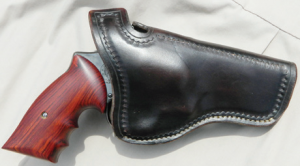
This holster from Cannon Leather, carries a vintage 1950s big frame .357 Smith. This is good gear for those who need a rugged holster. Note, Ahrends grips on the .357.
Another gumshuck that some love and some detest is the crossdraw. The crossdraw is good medicine for a certain amount of problem solving and should be avoided like poison for others. When you are seated in a vehicle or behind a desk, the strong side belt scabbard isn’t ideal. The same is true for any mounted duty from horseback to airboat patrol or hunting in brush. A regular holster may cause the user to lean too far forward on the draw. The body cannot lend adjustment and in the end you have a very slow draw. The crossdraw is particularly well suited to those that are willing to master the draw and learn to lean the body toward the weak side. A brilliantly fast draw that engages the attacker in this manner is possible. The crossdraw is sworn to by a number of very experienced individuals. The Blocker crossdraw remains one of the all-time classic designs and one I use often. But, you have to be certain that it fits your lifestyle and that you are willing to master the holster.
A classic rendition of the snubnose holster for real speed comes from Jeff Silvester of Silver Star Custom Leather. There is nothing faster than this design, and while the design is far from the easiest to form and make, it is a practical and affordable design well suited to the .38 Special snub nose. If you are going to deploy the lifesaving .38 snub, then you need a strong, secure and fast holster. Among the many good attributes of the snub .38 that is seldom mentioned is that the beast is fast from good leather. With a holster that tilts the butt forward, shoot the elbow to the rear and scoop the piece out of the holster and you have something. Some of the modern holsters are excellent designs from a flowing imagination and must be appreciated. But some are classics that are well worth your time and effort to examine.
When the totality of concealed carry and the demands of each situation are studied, among the best designs is the inside-the-waistband holster. The colt allows carry of a serious handgun inside the waistband without any of the body of the handgun protruding beneath the belt. Even a light, pulled out sport shirt will conceal a handgun in this manner, and a flat handgun such as the Colt 1911 Government Model is easily concealed under a heavy, good quality T-shirt. The IWB is the best all-around choice for concealed carry. While some acclamation is demanded, the holster offers excellent concealed carry. When looking into the best holsters do not let simplicity impede function. The holster may be minimal if it does the business but it must have the features that make for a good design As an example, the simplest or the most complex holsters share certain features.
A QUICK NOTE ON BREAK IN
When breaking in the holster, take your time! It will take a few days and several draws – perhaps several dozen – to achieve the best fit and speed. The best way is to begin with a triple-checked, unloaded handgun and wear the rig around the house for a few days. Time and body heat will form the holster properly. Draw and reholster, making certain the handgun is firmly holstered and completely seated with each draw. You may even wrap the unloaded gun in a thin layer of Saran wrap and holster the piece overnight. Don’t overdo it, but this will usually speed up the break in.
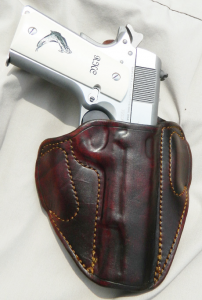
This is a well made pancake from Lobo Gun Leather. Fit is great and the body hugging holster gives good concealment.
Let’s look at the Occidental Leather holster. Occidental isn’t often mentioned in the popular press and seems a secret save for a few savvy professionals. There is a waiting list but the holsters are well worth the wait and the price. They are a real value. But would you really be able to use another holster without certain salient features? The Occidental holster features a sewn-in sight track. In the days of the GI .45 it did not matter as much. But today we use blunt and blocky front sights. Some are better than others but some would snag on a holster that is not blocked and waxed well. The holster features a steel band in the welt that prevents the holster from collapsing once the pistol is drawn. You may draw and reholster with one hand. My example features the exact correct cant for a rapid presentation but also features a special large spine or foot that keeps the pistol and the holster steady in the waistband.
If your holster is loose, you will bind on the draw and your hip muscles will also bind trying to keep the damn thing steady. A good holster that rides close to the body must be supported by a heavily constructed gun belt. They are not ugly, they are another example of the holster maker’s art, in fact a well-made gun belt. This holster from Jeff Silvester of Silver Star is designed to keep the holster tight to the body and it does. This is a first class design that is also well executed.



